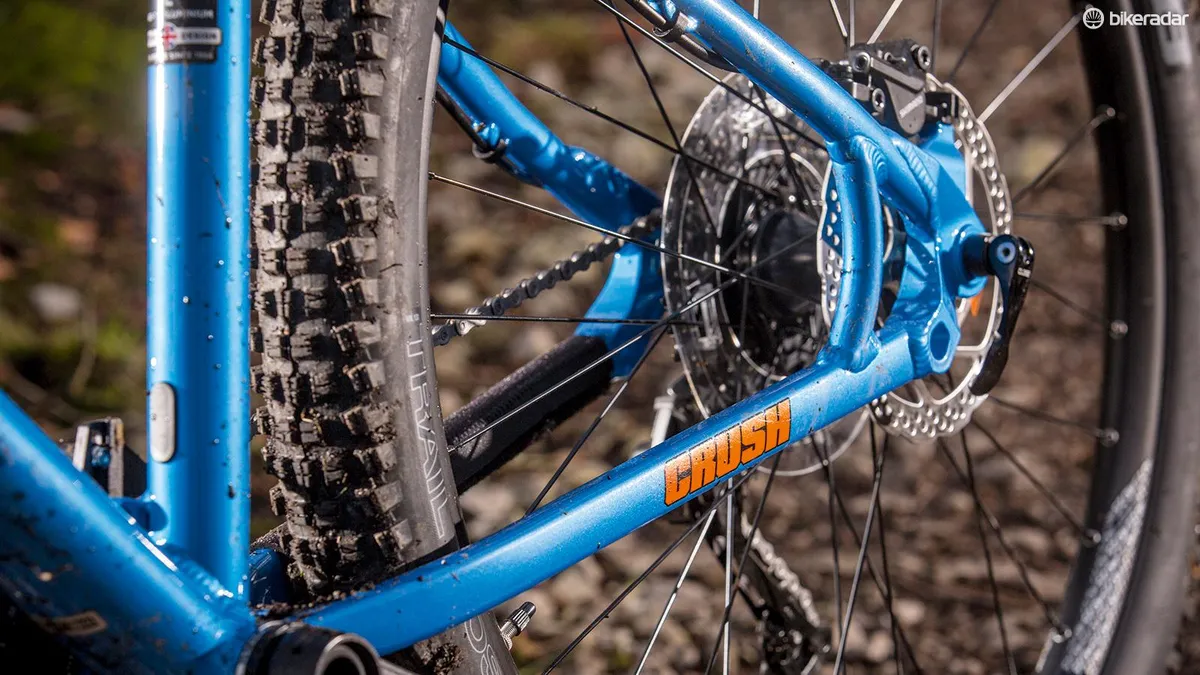Orange revised the Crush for 2016 and it's tweaked it again this year, with a slacker head angle and longer front end that are now only 0.5 degrees steeper and 10mm shorter than the numbers of its 160mm-travel Alpine 6 enduro bike. Orange has uprated the spec to suit too.
The Crush chassis is built to last. There’s a big, forked throat gusset under the down tube (which goes from flat-sided to ovalised) to back up the concave 44mm head tube.
The E-type front derailleur mount is fitted with a top guide for the chain as standard but there are ISCG tabs if you want a full-wrap device. A-frame chainstays leave mud room around 2.4in tyres, and the 142x12mm rear axle sits in replaceable inserts. The seat tube is braced and ported for a dropper.

There’s a RockShox Yari RC fork up front, rather than last year’s Revelation, with a wider stance to handle a stiffer Boost front hub. You’re also getting a heavy-duty WTB rear tyre and a full set of Shimano SLX 11-speed gears driven through a Race Face crankset.

That adds nearly 800g (12.8kg vs. 13.6kg), but also a load of extra capability. I’d prefer to see bigger rotors on a bike that wants to go as fast as the Crush. I also had some issues with the cockpit, and it’s gagging for a dropper post upgrade. But with a frame-only price of £475, the kit is pretty good value.
Orange Crush S ride impression
With a reach of 452mm on my large sample, a 65-degree head angle and a low bottom bracket (BB) height, the Crush is definitely on point in terms of the ‘stretched, slack and slammed’ full-gas handling mantra. You get to see plenty of front wheel and fork in front of the Kore bar too.
Its slightly odd shape does mean that rotating it to the right angle is crucial to reduce an otherwise hard to isolate feeling (I double-checked head angle and fork offset) that the steering is slightly steeper and twitchier than it actually is.

Even then, I’d still be tempted to switch to a wider bar and even shorter stem than the 50mm unit provided. That’s because the Orange’s BB height and long wheelbase make it such a stable and naturally aggressive corner hooker that you’ll want all the trip-switch stem reaction and power-steering bar leverage you can get to slam it as hard as possible into corners.
The ‘High Grip’ compound WTB Vigilante front tyre lets you push hard, and the structurally rock-solid but impressively sensitive performance of the 35mm-stanchion fork locks it into line and onto the ground.

While the Yari’s Motion Control damper can’t compete with the Charger damper in the Lyrik, it’s still a very good partner when things get punchy, and certainly a lot more capable and controlled than last year’s Revelation. Plus if you do find it ultimately limiting, there’s always the option to update to a Charger damper in the same fork.
Despite the unforgivingly stiff ‘Tough’ carcass of the Trail Boss rear tyre and the chunky alloy construction, the back end of the Crush isn’t as punishing as you might think either. Yes, if you wallop the rear wheel into something hard you’ll know about it, but it doesn’t hammer your feet forward into your shoes and knock the bike out of balance.

Things got significantly better when I swapped in the lighter rear tyre of the Ragley too, so if you can ride smoothly enough to get away with less impact-proofing, that’s a comfort and flow boosting option.
A lighter rear tyre would improve acceleration slightly too, although most of the excess rear wheel weight is in the NX cassette, where it makes little dynamic difference.
The harder rear rubber and efficient power transfer mean climbs or transfers between fun bits aren’t too arduous anyway, and the amount of fun you’ll have when things get tasty means it’s always worth the effort.





